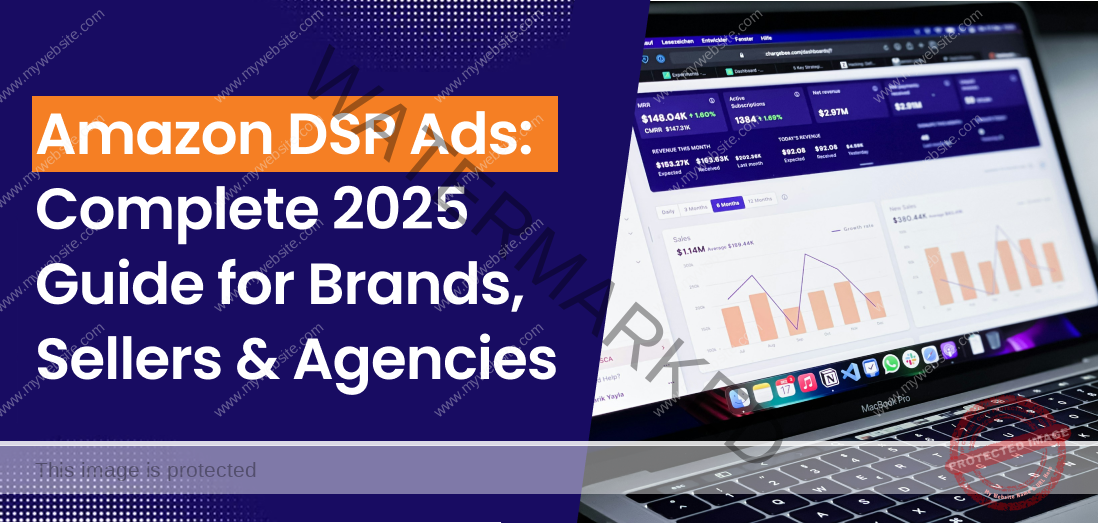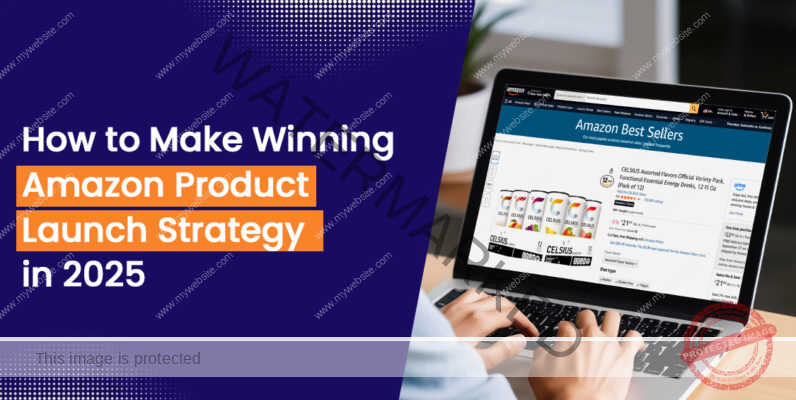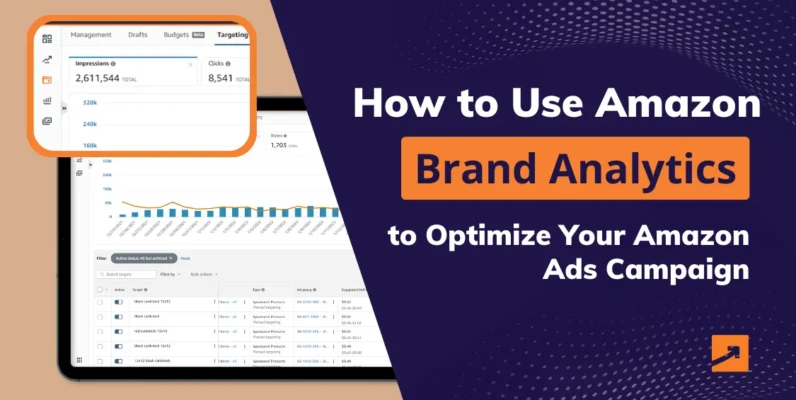Key Takeaways
- Amazon DSP covers the full funnel. It enables programmatic display, video, audio, and CTV to drive awareness, consideration, and conversions on Amazon and across the open web
- Targeting uses real shopper data. First-party signals, lookalikes, CRM onboarding, and retargeting improve relevance and lift ROAS versus third-party segments.
- Reach and growth accelerated in 2024. Spend rose 18% year over year and impressions rose 65%, while U.S. ad-supported reach passed 300 million users.
- Costs remain manageable with planning. Expect CPMs around $5–$15. Set budgets by goal, apply frequency caps, and choose bid models that match KPIs.
- AI and discipline boost performance. Brand+ and Performance+ optimize creatives and bids; a strict checklist, weekly tests, and AMC measurement sustain results.
Imagine your products reaching the right shoppers while they stream their favorite show on Twitch or browse top websites and apps. Competitors may only advertise within Amazon’s marketplace, but Amazon DSP gives you the advantage of going beyond.
With programmatic display, video, and audio ads across Amazon-owned channels and premium third-party platforms, DSP campaigns put your brand in front of high-intent audiences everywhere they shop, watch, and engage.
However, if you are wondering how you can use this advertising channel for your brand growth, give this guide a read. This guide explains how Amazon DSP works, who it’s for, and how to run campaigns that drive measurable ROI.
What Are Amazon DSP Ads?
Amazon DSP is Amazon’s demand-side platform. It allows advertisers to buy display, video, and audio ads across Amazon properties and external websites. The platform uses real-time bidding and Amazon’s first-party audience data to place DSP Amazon ads with precision.
Amazon DSP Ads appear on:
- Amazon.com, including homepages and product detail pages
- Fire TV and IMDb during streaming content
- Twitch, through live-stream placements
- Amazon Publisher Direct inventory on premium publisher sites
- Third-party websites and apps across open and private exchanges
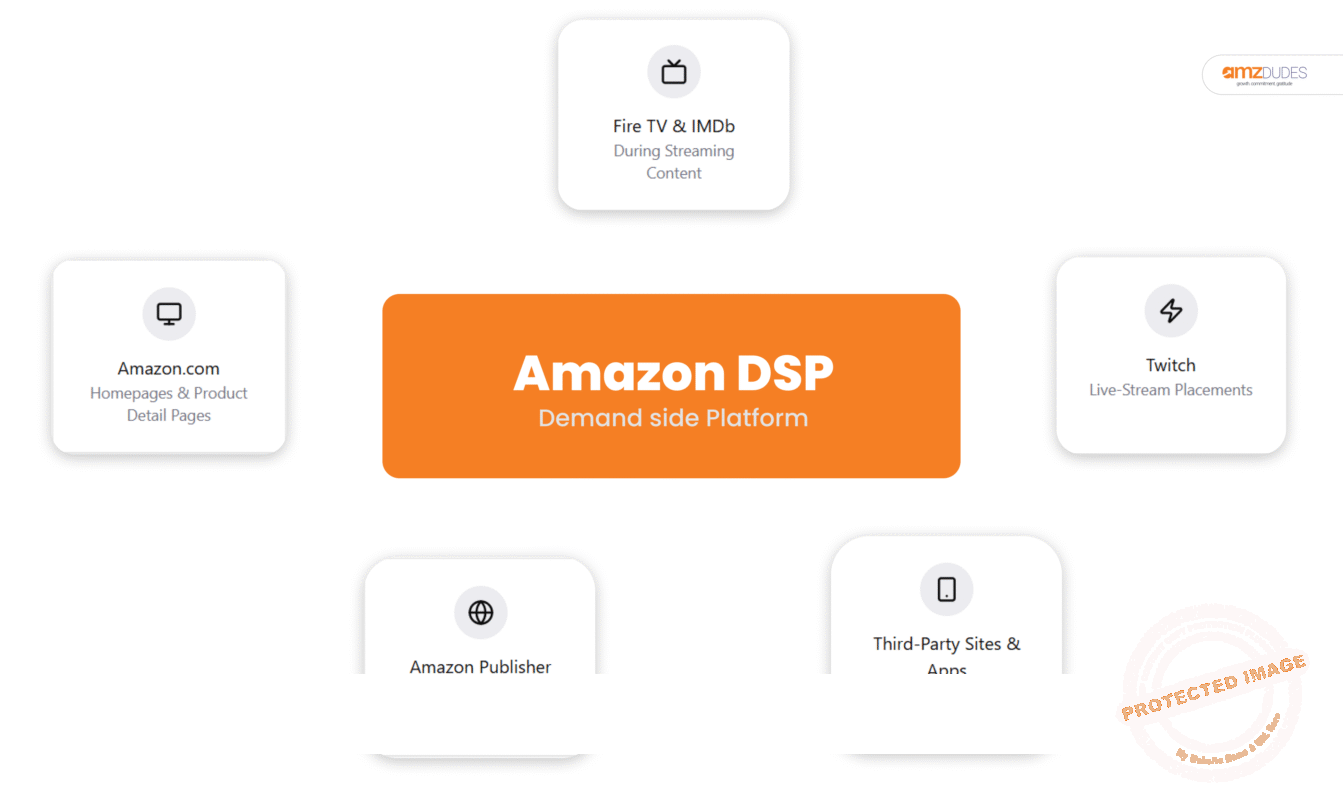
Amazon DSP focuses on audiences, not keywords. It works on a cost-per-thousand-impressions (CPM) model. Advertisers can reach shoppers outside of Amazon while maintaining visibility inside the marketplace.
Amazon DSP ads support remarketing, prospecting, and brand awareness goals. Through these Amazon retargeting ads, brands have access to shoppers who viewed specific products, visited specific pages, or matched key audience profiles.
The platform suits sellers who want to retarget store visitors, brands that aim to grow reach through video, and advertisers who do not sell on Amazon but want access to its data and audience scale.
DSP Amazon advertising offers campaign control, audience depth, and cross-channel coverage that keyword-based ads cannot match.
Why Amazon DSP Ads Matter in 2025
Amazon DSP ads play a key role in digital advertising strategies in 2025. It gives brands access to Amazon’s unique audiences, flexible campaign controls, and the ability to run ads across websites, apps, and streaming platforms. Its reach, control, and scale make it a smart choice for both growth and performance goals.
1. Reach
Amazon DSP reaches over 300 million monthly ad-supported users in the U.S. (Q4 2024), surpassing most ad networks. It includes access to exclusive Amazon audiences and high-intent shoppers. Advertisers can also extend reach through premium streaming services like Netflix, Hulu, and Disney+. This altogether gives your brand’s reach a boost.
2. Control
With Amazon DSP ads, you can choose managed service or self-service access with precise targeting, frequency caps, and custom bidding. Amazon DSP supports granular audience exclusions and negative retargeting. You can also control placements across channels, devices, and household-level segments.
3. Scale
Amazon DSP falls into the category of Amazon programmatic ads which gives off-Amazon visibility, helping brands move beyond marketplace ads into full-funnel programmatic advertising.
It supports awareness, retargeting, and loyalty campaigns through one platform.
You can run unified strategies across Amazon, Fire TV, Twitch, and third-party publishers.
Fact Check:
In 2024, Amazon DSP grew 18% YoY in spend, with impressions up 65% YoY, and average CPMs dropped due to cheaper third-party inventory.
Who Should Use Amazon DSP?
DSP advertising Amazon fits advertisers who want to scale beyond search ads and reach high-intent audiences across the web. It works for both endemic sellers and non-endemic brands. Businesses can use DSP to drive traffic to Amazon product pages or external websites, depending on their strategy. The platform also suits agencies that manage multiple clients and need centralized control with full-funnel capabilities.
| Audience Type | Why They Benefit |
| Amazon Sellers | Retarget store visitors, build lookalike audiences |
| Non-Amazon Brands | Reach Amazon audiences, link to external websites |
| Agencies & Resellers | Run DSP for clients with pooled budgets |
| Retail, CPG, Auto Brands | Use first-party intent data for contextual targeting |
Amazon DSP Ad Formats & Creatives
DSP Amazon ads offers multiple ad formats to help brands connect with audiences at different stages of the funnel. Whether you aim to build awareness, drive engagement, or re-engage past visitors, the platform supports creative types that fit your goals. Each format works across Amazon’s owned media and partner inventory, giving you broad reach and flexibility in how you deliver your message.
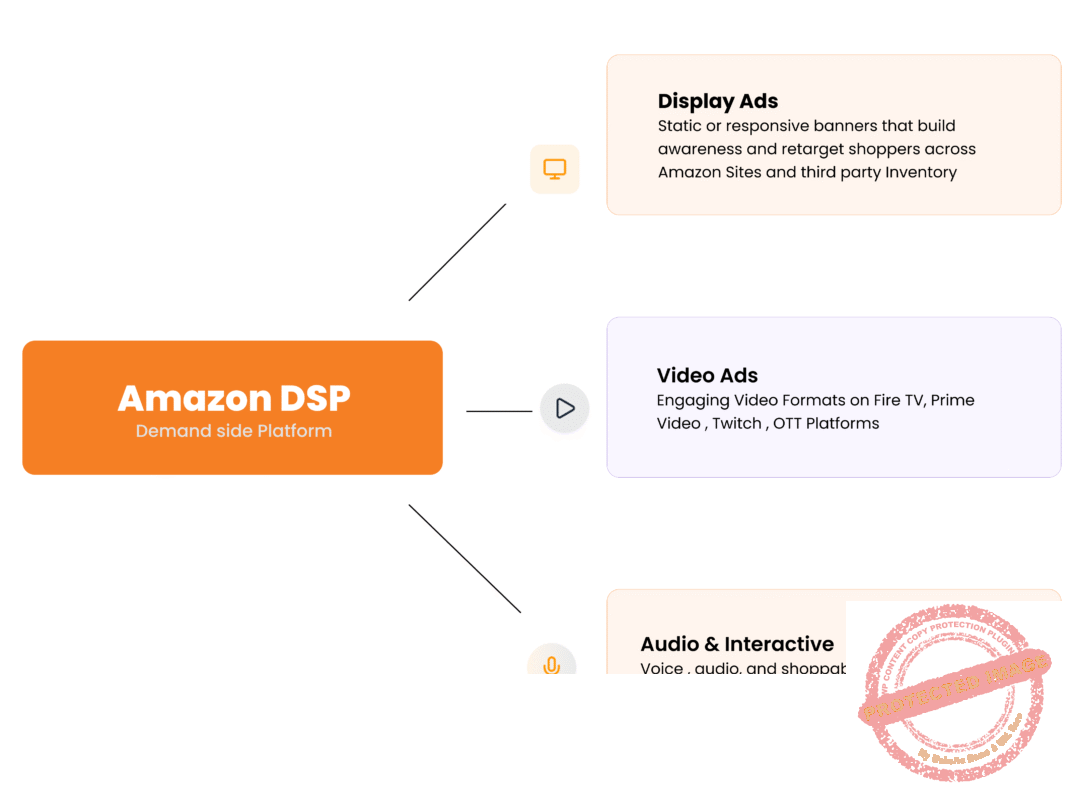
1. Amazon DSP Display Ads (Static or Responsive)
Amazon DSP Display Ads serve as foundational units for brand awareness, retargeting, and product discovery. These ads appear across Amazon-owned properties like Amazon.com and IMDb, as well as thousands of partner websites and apps through Amazon Publisher Direct and open exchanges. Static and responsive formats adapt to device sizes and maintain visibility across mobile, desktop, and tablet environments.
Specifications:
- Sizes: 300×250, 728×90, 160×600, 970×250
- Placements: Amazon.com, IMDb, Twitch, third-party publisher inventory
- Use Case: Retargeting, brand recall, product consideration campaigns
2. Amazon DSP Video Ads
Amazon DSP video ads drive emotional impact and brand engagement through full-screen storytelling. They appear across streaming platforms including Fire TV, Twitch, and Prime Video. In 2025, advertisers can also run video ads on external premium OTT platforms such as Netflix, Disney+, and Hulu via Amazon DSP’s expanded CTV inventory. Video formats work best for mid-to-upper funnel goals like brand lift and new customer acquisition.
Specifications:
- Length: 6 seconds, 15 seconds, 30 seconds, 60 seconds
- Placements: Fire TV, Prime Video, Twitch, and OTT/CTV apps (Disney+, Hulu, Netflix – Q4 2025)
- Use Case: Storytelling, brand awareness, mid-funnel audience engagement
3. Audio and Interactive Ads
Amazon DSP supports emerging formats such as audio and interactive placements that extend brand reach into non-visual environments. Audio ads run across Alexa-enabled devices and Amazon Music, allowing advertisers to connect during passive listening. Interactive formats include voice-enabled experiences and shoppable video units, which drive action directly within the content. These formats are supported by Brand+, Amazon’s AI-powered dynamic creative system that personalizes delivery based on audience behavior.
Specifications:
- Emerging Formats: Voice-enabled ads via Alexa, immersive and shoppable video units
- Creative Tools: Brand+ for dynamic creative optimization (DCO), AI-powered delivery
- Use Case: Conversational commerce, interactive engagement, audio branding
Setting Amazon DSP Campaign Objectives and Strategy
Every Amazon DSP campaign should begin with a clear goal. Defining the objective helps you select the right ad format, audience, and budget. Amazon DSP supports a full-funnel strategy, so you can build awareness, drive consideration, or increase conversions based on what your brand needs most.
Identify the Amazon DSP Campaign’s Objectives
Amazon DSP supports full-funnel advertising strategies by letting advertisers define campaign objectives before choosing ad formats, placements, and audiences. This structured approach helps align spend with measurable outcomes like reach, engagement, and return on ad spend (ROAS). Choosing the right goal at the start determines how Amazon DSP will deliver and optimize your ads across its network.
Most Amazon DSP campaigns fall into one of four core objective types.
- Brand Awareness: Display and Video
- Consideration: OTT/CTV, Mid-funnel Video
- Conversions: Retargeting and Lookalike Audiences
- Retargeting: Product viewers, abandoned carts
Align Formats with Funnel Stage
Each objective aligns with specific formats and KPIs. Awareness campaigns benefit from Amazon DSP video ads and OTT placements, where visibility and reach matter most. Mid-funnel efforts favor display or audio ads, focusing on engagement metrics like CTR and viewability.
Conversion campaigns rely on retargeting formats, where ROAS, CPC, and ACoS define success. Amazon’s Performance+ automation can assign the right bids and audiences to each stage, optimizing delivery based on goal type.
| Funnel Stage | Format | KPI |
| Awareness | Video / OTT | Impressions, Reach |
| Mid-Funnel | Display / Audio | CTR, Viewability |
| Conversion | Static / Retargeting | ROAS, CPC, ACoS |
Performance+ uses predictive AI to optimize bidding, targeting, and audience sequencing based on your chosen KPI. Advertisers who enable it often see reduced CPA and stronger conversion metrics with minimal manual input.
Amazon DSP Targeting Options Explained
Amazon DSP targeting can be divided into two main areas:
- Audience types
- Delivery dimensions
Audience targeting focuses on who sees your ads, using Amazon’s retail signals, custom data, and lookalike modeling. Delivery dimensions refine how ads are shown, controlling placement through behavioral, contextual, geographic, device, and frequency settings.
Available Audience Types in Amazon DSP
Amazon DSP uses verified intent signals gathered across its retail ecosystem to build highly accurate audience segments. These audiences reflect real purchase behaviors, not just interest-level signals like clicks or views. In 2024, advertisers using custom Amazon audiences achieved 30–60% higher conversion rates compared to third-party segments. The platform also supports onboarding your own data for deeper personalization.
These are the core audience types available in Amazon DSP:
- Amazon First-party Data (shopping/browsing signals)
- Lookalike Audiences (modeled after purchasers)
- CRM / First-party Onboarding (via Ads Data Manager)
- Retargeting (site visitors, product viewers, cart abandoners)
Other Targeting Dimensions
Amazon DSP enables granular delivery control beyond just audience segments. Advanced campaign setups now combine behavioral and contextual signals with geo and device-level filters to maximize relevance. You can refine campaign delivery using the following targeting dimensions:
| Targeting Type | Description |
| Behavioral | Shopping intent, interests, lifestyle |
| Contextual | Page content (e.g., beauty blogs, tech reviews) |
| Geo | Country, region, zip code, DMA |
| Device/OS | Mobile, desktop, Fire TV |
| Frequency Caps | Impressions per user/device/household |
Expert Insight: Frequency caps can now be set cross-campaign to reduce ad fatigue and increase incremental reach by 21%.
Amazon DSP Costs, Budgeting & Bidding
Amazon DSP requires careful planning around costs, budgeting, and bidding to achieve efficient results. Since the platform operates on a cost-per-thousand-impressions model, advertisers need to align budgets with campaign goals and choose bidding strategies that balance control with automation. Understanding these financial and strategic components ensures campaigns scale effectively without overspending.
How Amazon DSP Ads Charges
Amazon DSP uses a CPM pricing model, where you pay for every 1,000 impressions your ad delivers. The average CPM typically ranges between $5 and $15, depending on audience targeting, format type, and inventory quality. For brand-focused campaigns, Amazon also offers viewable CPM pricing, which ensures you’re only charged when ads meet specific viewability standards. This model helps advertisers control costs while focusing on high-quality impressions that support brand lift and reach.
How to Set Budget for Amazon DSP
Advertisers planning to use Amazon DSP should align their budget with campaign goals and media formats. Costs can vary based on targeting depth, inventory type, and geographic reach. While Amazon’s self-service DSP traditionally required a minimum spend of $35,000, many certified resellers now offer entry points as low as $5,000 per month, often without added tech fees. The following benchmarks provide guidance on how to allocate budget by campaign type.
| Campaign Type | Recommended Budget |
| Retargeting | $5K–$10K/month |
| Prospecting | $15K+ |
| OTT/CTV Video | $20K+ |
Minimum self-service budget: Historically $35K, but resellers now offer access from $5K with no tech fees.
Choosing Bid Strategies for Amazon DSP
Amazon DSP gives advertisers several bidding models that balance control with automation. Choosing the right strategy depends on campaign goals, available data, and the desired level of oversight. Each option offers unique advantages that can shape cost efficiency and performance outcomes.
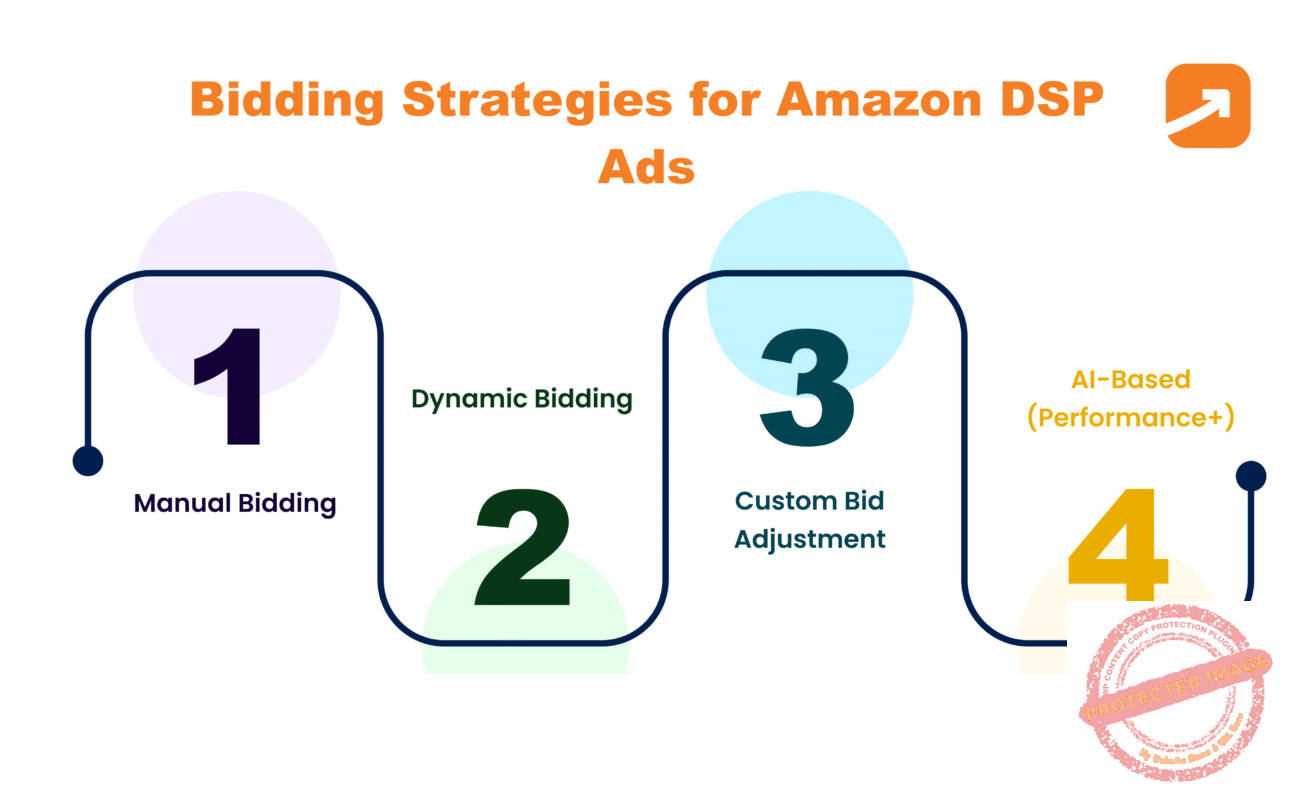
- Manual Bidding
Manual bidding allows advertisers to set CPMs at the line-item level. This approach offers full control and is best suited for teams that want to closely monitor costs while testing different audience or placement strategies.
- Dynamic Bidding
Dynamic bidding adjusts CPMs automatically based on real-time signals such as audience value, placement quality, and likelihood of conversion. It reduces wasted impressions and helps scale campaigns more efficiently.
- Custom Bid Adjustments
Custom adjustments use APIs to modify bids with external triggers like stock availability, time of day, or even weather conditions. This method provides advanced flexibility for brands that need highly tailored delivery rules.
- AI-Based (Performance+)
Performance+ is Amazon’s AI-driven bidding solution. It optimizes automatically toward the chosen KPI, such as lower CPA or higher CTR. This option suits advertisers who prefer automation and want to maximize efficiency without heavy manual input.
Creative Best Practices for Amazon DSP Ads
Strong creative assets determine how well your campaigns capture attention and drive action. Amazon DSP campaigns work best when ad messaging, visuals, and formats are designed with clarity and user behavior in mind. By following proven frameworks, you can improve engagement and maximize return on ad spend.
Messaging Structure
Clear messaging helps communicate value within seconds. Ads should start with a hook that grabs attention, followed by a statement that shows your unique value, and end with a direct call-to-action. This sequence ensures the message is both memorable and actionable.
Sample Ad Message:
“Tired of restless nights? Discover our best-selling memory foam pillows trusted by over 10,000 customers. Shop now and sleep better tonight.”
Visual Design
Good design helps an ad stand out and remain memorable. Amazon DSP display creatives must balance brand clarity with user-friendly layouts. To ensure effectiveness, advertisers should follow a simple design checklist.
Checklist for Visual Design:
1. Use high-resolution product images that remain clear on mobile and desktop
2. Place brand logos in a consistent, visible position
3. Limit text to short, scannable phrases for quick impact
4. Apply color contrast that supports readability and brand recognition
5. Align creative elements with Amazon’s brand-safe standards
For Video Creatives
Video ads on Amazon DSP succeed when they combine storytelling with measurable engagement. Research shows that concise, branded videos generate stronger recall and lower drop-off rates. Advertisers should plan video assets with these practical checks.
Checklist for Video Creatives:
1. Show branding or product within the first 3 seconds
2. Keep length under 30 seconds for mid-funnel impact
3. Add captions to reach viewers who watch with sound off
4. Use strong thumbnails and opening frames to attract attention
5. Include a clear call-to-action in both visuals and audio
Testing & Optimization of Amazon DSP Ad Creatives
Creative testing and optimization are essential for keeping Amazon DSP campaigns efficient and impactful. Ads lose effectiveness when audiences see the same message too often, and without structured testing it is difficult to know which elements truly drive results. So, below are the tactics that will help you find out the winning creative.
| Tactic | Why It Works |
| A/B Testing | Compare formats, messages, CTAs |
| Refresh Creatives | Avoid fatigue every 2–4 weeks |
| Exclude buyers | Use negative audiences to save budget |
Measuring Amazon DSP Performance
Measurement is critical to ensure Amazon DSP campaigns deliver meaningful business results. By tracking the right performance signals, advertisers can evaluate the effectiveness of spend, optimize campaigns in real time, and validate the role of DSP in the broader media mix.
Key Metrics to Monitor
Amazon DSP provides a range of performance indicators that cover awareness, engagement, and conversion outcomes. These metrics help advertisers understand reach, user behavior, and sales impact across both Amazon and third-party inventory. The most important ones include:
- Impressions & Reach
- CTR (average ~0.34%; top 1% can hit 1%+)
- Conversions (up to 10% on Amazon)
- ROAS
- Viewability & Frequency
Attribution Insights
Attribution in Amazon DSP explains how ads influence customer decisions across devices and channels. Standard models include both view-through and click-based attribution, but advertisers seeking deeper insight can use Amazon Marketing Cloud for incrementality and cross-funnel measurement. Available options include:
- View-through attribution default is 14-day post-view
- Click-based attribution for performance campaigns
- Use AMC (Amazon Marketing Cloud) for advanced incrementality measurement
Optimization Tactics for the Best Performance
Optimization ensures that campaigns adapt to changing audience responses and inventory conditions. Advertisers can refine targeting, shift budgets, and rotate creatives to sustain performance. Amazon DSP also provides built-in dashboards and tools that simplify decision-making. Common tactics include:
- Shift budget to high-converting segments
- Pause underperformers
- Test alternate creatives and formats
- Use Amazon’s Campaign Health Dashboard, AMC, and Ads Data Manager for reporting
Tip: Use Amazon’s Campaign Health Dashboard, AMC, and Ads Data Manager for reporting.
When Not to Use Amazon DSP Ads
Amazon DSP is a powerful platform, but it is not the right solution for every advertiser or campaign. Some situations call for simpler, lower-cost ad types or different programmatic platforms. Understanding these limits helps brands avoid wasted spend and focus on the most effective approach for their goals.
Common Pitfalls of Amazon DSP
Advertisers often see poor results when they start with budgets that are too small, run campaigns for short periods, or skip proper testing. Over-reliance on default attribution can also misrepresent performance by over-crediting view-through conversions. Without a creative testing strategy, campaigns risk stagnation and declining returns. The following are the most common pitfalls to avoid:
- Too small a budget with high CPM goals
- Short test runs (under 2 weeks)
- Relying only on default attribution
- No creative testing strategy
When Alternatives Make Sense
Some campaign goals are better served by other Amazon ad types or competing DSPs. Sub-categories of Amazon AMS ads such as Sponsored Products remain the best option for keyword-driven sales, while Sponsored Display suits advertisers targeting specific product pages.
For advertisers seeking broader reach or more flexible open web buying, platforms such as DV360 or The Trade Desk can sometimes be a better fit. Below are examples of when AMS Amazon ads and open web buying options may work better:
| Use Case | Better Option |
| Keyword search intent | Sponsored Products |
| Product page targeting | Sponsored Display |
| Flexible open web buying | DV360, The Trade Desk |
Trends & What’s Coming in Amazon DSP (2025-2026)
Amazon DSP continues to evolve as Amazon expands inventory, improves targeting, and integrates AI-driven tools. These updates reflect the growing importance of programmatic media in e-commerce and brand marketing. The following trends highlight where the platform is heading in 2025.
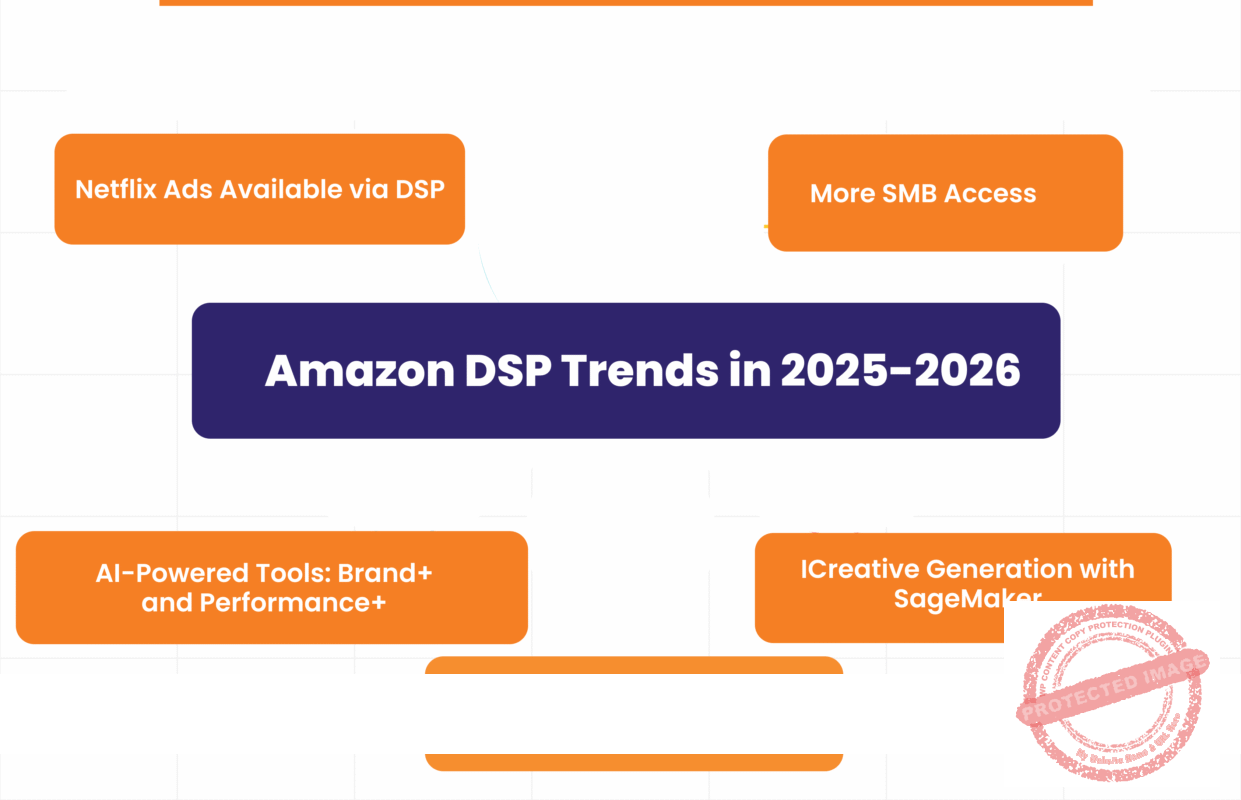
1. Netflix Ads Available via DSP
From Q4 2025, advertisers will gain access to Netflix ad inventory in 11 countries through Amazon DSP. This expansion strengthens Amazon’s position in connected TV by offering premium streaming placements previously unavailable. It allows brands to tap into global audiences within one buying platform.
2. AI-Powered Tools: Brand+ and Performance+
Amazon’s Brand+ and Performance+ tools use artificial intelligence to streamline creative development and campaign optimization. Brand+ assists with dynamic creative adjustments, while Performance+ automates bidding toward specific KPIs. Together they reduce manual work and improve cost efficiency across campaigns.
3. New CTV Partners
Amazon DSP is adding premium connected TV inventory through partnerships with Disney+, Hulu, Max, and ESPN. These integrations broaden reach in high-quality streaming environments. For advertisers, this means better opportunities to combine storytelling with measurable outcomes at scale.
4. Creative Generation with SageMaker
Generative AI is reshaping ad production. Amazon now integrates its SageMaker platform to create custom images and video elements for DSP campaigns. This helps brands accelerate creative testing, cut production costs, and adapt messaging to different audiences quickly.
5. More SMB Access
Historically, high minimum spends limited DSP to larger advertisers. In 2025, resellers now make Amazon DSP available to small and mid-sized businesses with budgets under $10,000. This shift opens programmatic advertising to a wider pool of sellers and brands.
Amazon DSP Campaign Checklist
Running Amazon DSP campaigns can get complicated. There are goals to set, audiences to define, creatives to design, and performance to measure. Without a clear process, things can slip through the cracks. A simple checklist keeps everything organized and helps you stay on track. Here’s a free checklist that will guide you step by step as you plan and launch your next Amazon DSP campaign.
Conclusion
Amazon DSP ads help brands expand reach, control targeting, and scale campaigns across the full funnel. Success depends on setting clear goals, choosing the right bidding model, and tracking key metrics like ROAS, conversions, and viewability. A simple checklist keeps campaigns structured, creative fresh, and optimizations consistent.
However, if you are still unsure about the execution of Amazon DSP, let us help you. At AMZDUDES, we manage Amazon DSP ads with measurable results. Book a free consultation call today to plan your Amazon DSP strategy and let the number speak for themselves.
FAQs
Q1. What is Amazon DSP ads?
Amazon DSP ads are programmatic display, video, and audio placements purchased through Amazon’s demand-side platform. Unlike Sponsored Products, they use Amazon’s first-party shopper data and real-time bidding to reach audiences both on and off Amazon.
Q2. Where do Amazon DSP ads show?
Amazon DSP ads appear across Amazon.com, Fire TV, IMDb, Twitch, Amazon Publisher Direct, and thousands of third-party websites and apps. They can also run on premium OTT platforms like Netflix, Disney+, and Hulu.
Q3. How much does Amazon DSP cost to start?
The self-service minimum is usually $35,000, but resellers now provide access starting at $5,000 per month. Typical CPMs range from $5–$15 depending on targeting, format, and inventory.
Q4. Who should use Amazon DSP ads?
DSP is ideal for Amazon sellers who want to retarget visitors, brands aiming to expand reach with video and CTV, and non-Amazon businesses that want to access Amazon’s retail audiences. Agencies can also manage DSP at scale for clients.
Q5. How do you measure Amazon DSP performance?
Key metrics include impressions, CTR, conversions, ROAS, and viewability. Advertisers can use Amazon Marketing Cloud (AMC) for incrementality testing and multi-touch attribution across devices and channels.

